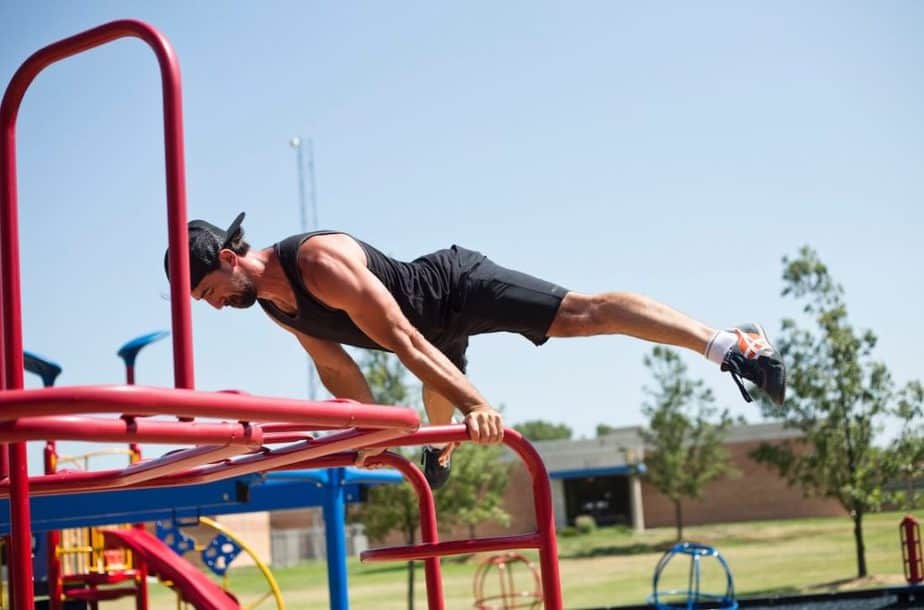Calisthenics is the best way to gain holistic strength. Calisthenics exercises always engage numerous muscles, encouraging balanced muscle growth and development. When you train with weights its easy to isolate muscles and over-focus on a single muscle or muscle groups; with calisthenics this is almost impossible.
Gaining strength quickly and effectively requires exercising in a specific way. Follow these 10 simple rules for gaining strength with calisthenics exercises. Your body weight is all you need to become strong and powerful!
1. Low Reps
If your goal is to increase your strength then you need to focus on doing just a few repetitions. Complete each movement slowly. For example, if you are doing a pushup, count to 5 as you descend and count 5 again when you ascend into starting position. The total number of reps should not last more than 15-20 seconds. This is because short, intense movements of the body are fueled by an energy system called ATP-PC which lasts between 10-20 seconds. This energy source is the most effective for building strength and so we want to utilize it when doing strength training.
2. High Weight
To make each of your reps counts, you need to lift a heavy weight. In regards to calisthenics this can mean using bars, rings, or other apparatus, to use the most of your body weight possible when doing an exercise. If there is no way of increasing the weight you can try doing the movement even more slowly, which will increase the intensity.
3. Many Sets
Just as important as low reps is high sets. With strength training its all about adding more sets; as your muscles strengthen you will be able to add more sets to your workout, thereby progressively building muscle strength. Push your limits!
4. 3-Minute Intervals
Rest between sets for at least 3 minutes. 3 minutes it the time it takes for your ATP-PC system to replenish.
5. Avoid Muscle Failure
Muscle failure is where you do more reps than your muscle can handle and, as a result, you cannot complete your final rep. Muscle failure can be useful for building muscle mass, however, when you are focusing on strength training muscle failure should be avoided. Muscle failure can exhaust the muscle making recovery time longer, and it teaches the body to do incomplete movements. With strength training you want to complete each rep fully; stop training when you think you will not be able to finish the next rep.
6. Increase the Difficulty Progressively
In order to build strength you will need to progressively increase the difficulty of the movement. This can be through increasing sets, or it can be through increasing the weight. For example, you might start by doing pushups on your knees and work up to doing pushups in the regular position. If you do not increase the difficulty your strength will plateau.
7. Do not Use your Body’s Momentum
Do not use your body’s natural momentum to complete a rep. Instead, always make your muscles do all the work. I often see this problem when people are doing pull ups: the first rep is difficult as they pull up from a static pose, then they use their legs and the body’s momentum to bod up and down on the pull up bar. This does not build strength as your muscle is not being fully utilized.
8. Be sure to Warm Up
This is vitally important! Getting an injury can set you back weeks. Always warm up properly before strength training. Go on a short run to get your body warm and follow the run with light stretching. Before performing a difficult exercise do an easier version which uses the same muscle groups.
9. Utilize Power Training
Power training is where you combine a strength building exercise with speed. Rather than focusing on slow and heavy sets, focus on speed. Box jumping is good power exercise, push ups can also be used. Make sure you don’t sacrifice form to increase your speed. Each set should be completed perfectly, but quickly. Power training activates a separate part of the muscle to strength training but both need to be exercised in order to build holistic strength.
10. Avoid Plateaus by Adapting your Movements
If you insist on performing the same movement again and again your body will eventually stop improving as it become accustomed to the movement. Adapt your movements over time to avoid plateaus.

